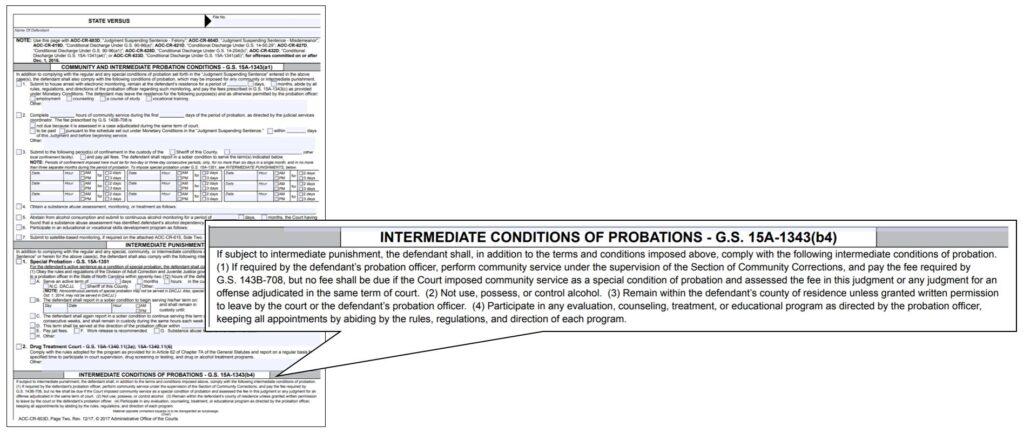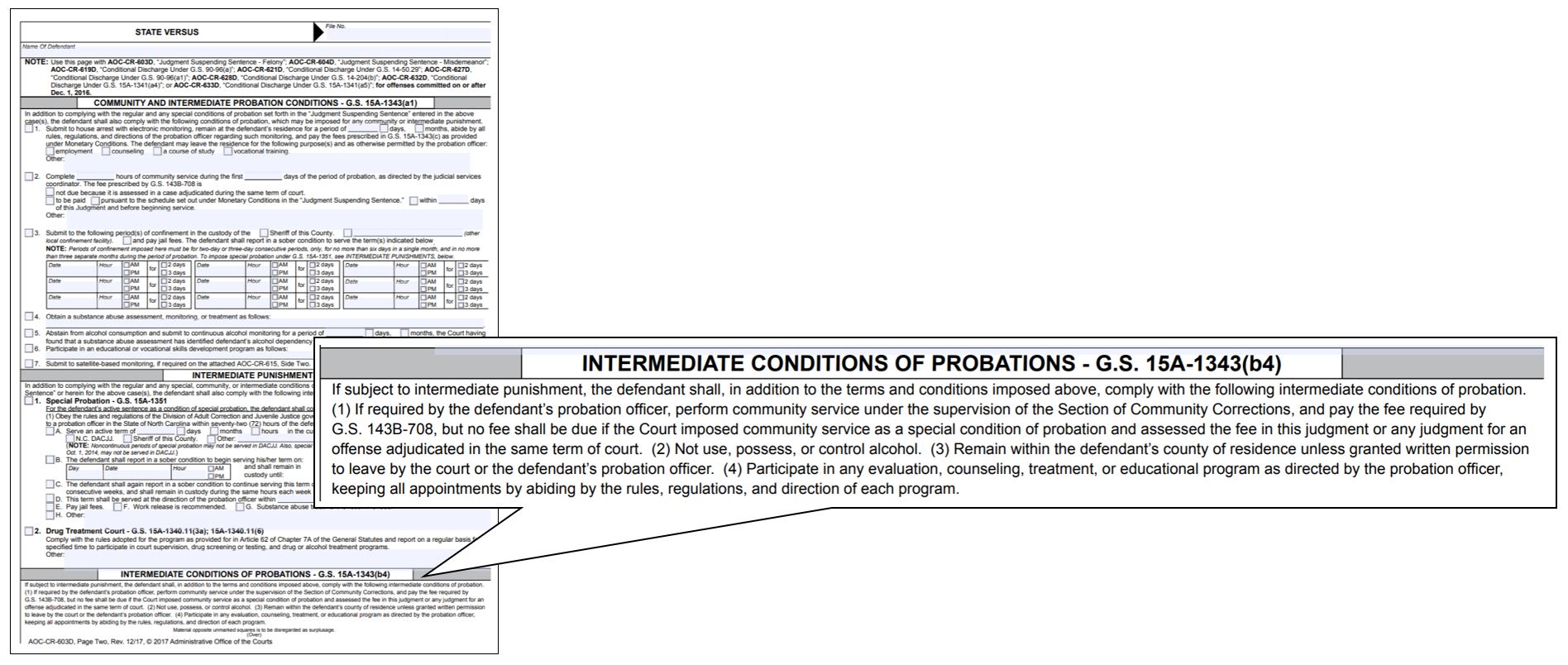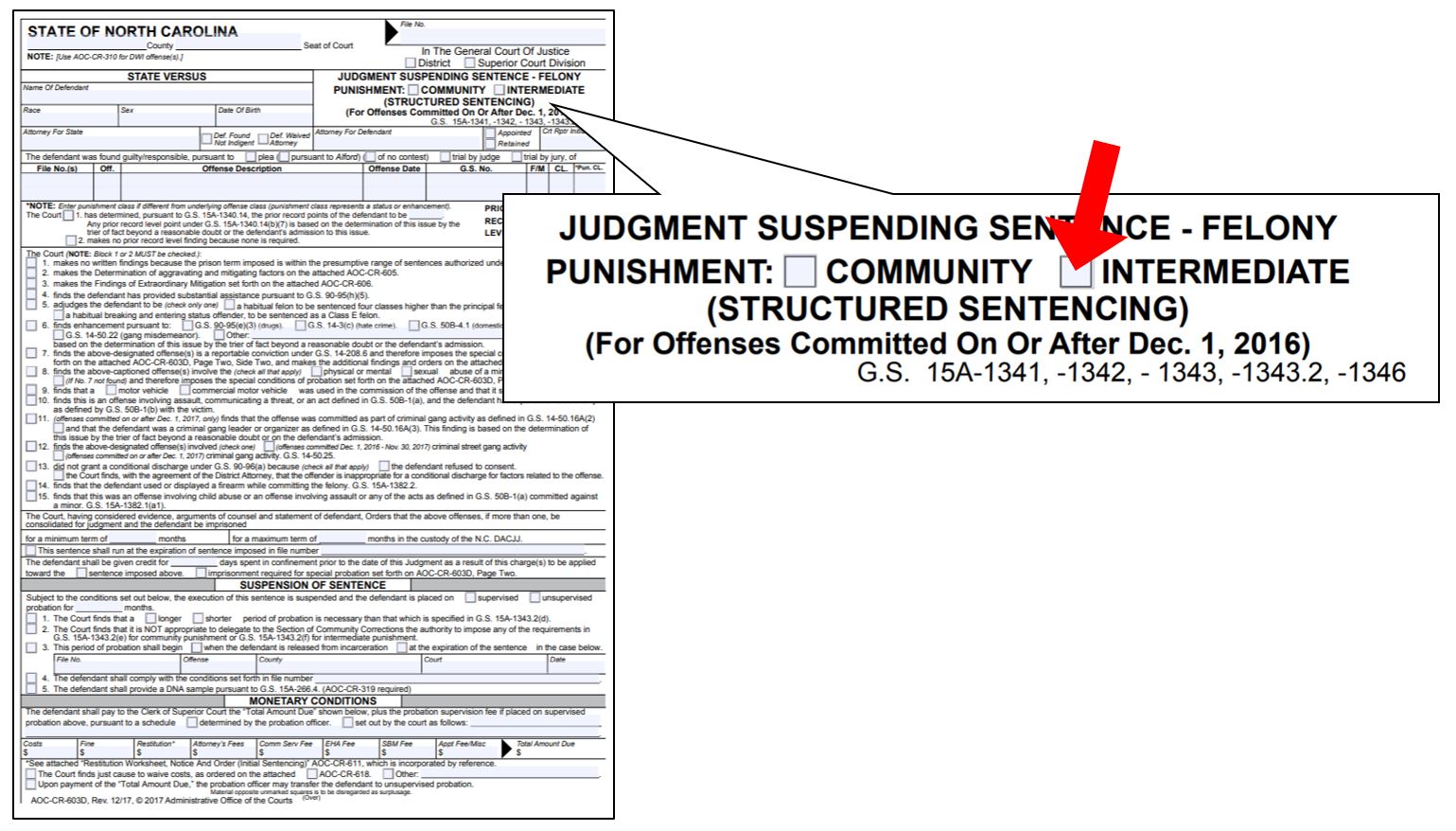
I have been asked a few times lately which conditions of probation are “intermediate” conditions of probation. It turns out to be a little bit complicated.
Intermediate conditions. In 2009, effective for offenses committed on or after December 1, 2009, the General Assembly added four conditions of probation that were styled as “Intermediate Conditions.” S.L. 2009-372. Those conditions, set out in G.S. 15A-1343(b4), are:
- If required in the discretion of the defendant’s probation officer, perform community service under the supervision of the Section of Community Corrections of the Division of Adult Correction and Juvenile Justice and pay the fee required by G.S. 143B-708.
- Not use, possess, or control alcohol.
- Remain within the county of residence unless granted written permission to leave by the court or the defendant’s probation officer.
- Participate in any evaluation, counseling, treatment, or educational program as directed by the probation officer, keeping all appointments and abiding by the rules, regulations, and direction of each program.
The conditions appear at the bottom of Page Two of a probationary judgment form.
The intermediate conditions apply to “each defendant subject to intermediate punishment,” unless the judge specifically exempts the defendant from one or more of them. The statute says that the judge need not state each of the conditions in open court, but the defendant must receive them in writing. In that regard the intermediate conditions are like four extra “regular” conditions of probation that apply to defendants who are subject to intermediate punishment—seemingly whether that punishment was imposed at sentencing or added later as a modification of probation.
Other special conditions of probation (like the gang conditions, or a requirement to attend DART Cherry, for example) may be added in an intermediate case, but only the four additional conditions apply automatically. Intermediate punishments also may, in the judge’s discretion, include any of the “community and intermediate probation conditions” listed in G.S. 15A-1343(a1), but we don’t even really need to talk about those for the purpose of today’s post.
So the general rule is simple enough: the four intermediate conditions apply automatically to defendants subject to an intermediate punishment. But what is an intermediate punishment?
Effective for offenses committed on or after December 1, 2011, an intermediate punishment is defined as a sentence under Structured Sentencing (which is pretty much anything aside from DWI) that places a defendant on supervised probation and may include drug treatment court or special probation (a split sentence). G.S. 15A-1340.11(6). Before that effective date, an intermediate punishment was defined as supervised probation that was required to include at least one of six specified conditions (intensive supervision, a split sentence, electronic house arrest, a residential program, day-reporting center, or drug treatment court), and any term of probation that did not include at least one of those conditions was, by definition, community punishment. Under the revised definition, cases that include a split sentence or drug treatment court are clearly intermediate punishment, but there are many sentences imposed under the new definition that do not include either a split or drug treatment court that are also intermediate.
If that sounds a little confusing, it’s because it is. And to make matters worse, nearly a decade after the definitional change, the court system’s computers don’t seem to always recognize the distinction between community and intermediate punishment. In Fiscal Year 2018, 3,995 out of 8,464 sentences (47 percent) identified as “community” came from sentencing grid cells in which a community punishment is not allowed because there is no “C” in the cell. I noted the issue in this prior post, and the Court of Appeals picked up on it in a footnote in State v. Duff, 825 S.E.2d 277 (2019) (unpublished).
As to the intermediate conditions themselves, they can be significant. One that catches some probationers by surprise (remember, the judge need not say it aloud in court) is the condition forbidding the use, possession, or control of alcohol. It applies to any probationer sentenced under Structured Sentencing—felon or misdemeanant—who receives an intermediate punishment, regardless of whether the crime had anything to do with alcohol or other substance abuse. The first and fourth intermediate conditions (perform community service if required by the probation officer; and participate in any evaluation, counseling, treatment, or educational program as directed by the probation officer) are functionally similar to conditions an officer can add through delegated authority under G.S. 15A-1343.2 (i.e., perform up to 50 hours of community service, and participate in an educational or vocational skills development program), although unlike delegated authority the intermediate conditions do not include a provision allowing for judicial review of officer-imposed requirements.
Given the potential impact of the intermediate conditions, it important to be clear about when they apply. If a judgment is misidentified as community punishment when it ought (by law) to be intermediate punishment, the probation officer and probationer may not know that the four intermediate conditions are supposed to be in effect. With that in mind, I encourage judges to be sure that the large check-boxes at the top of any suspended sentence judgment form properly categorize the type of punishment (community or intermediate) that the judgment imposes.


